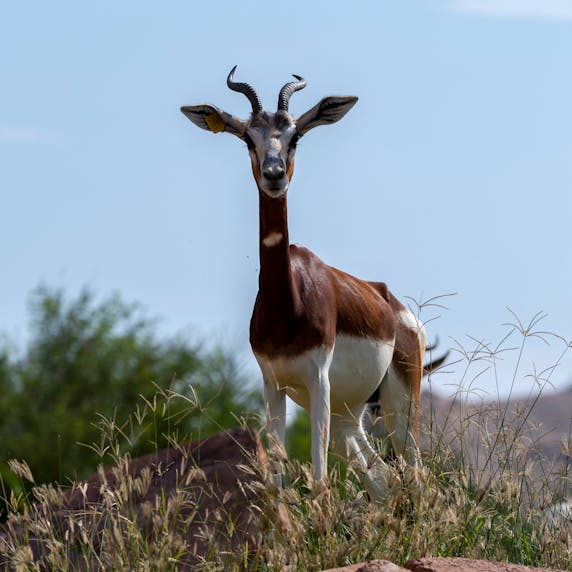
The mhorr gazelle is one of the rarest antelopes in the world. In fact, by the mid-20th century, the mhorr gazelle was extinct in the wild! Fortunately, mhorr gazelles still lived in zoos, which together set up a population management program. Rotterdam Zoo still participates in this program, helping to protect this special ungulate.
Nanger dama mhorr

12 years
75 centimeters
1.60 meters
85 kilograms
This slender-built antelope can be recognized by its brown back, white belly and white tail. Its face is also white with dark brown markings around the eyes. Both males and females have horns, although they tend to be longer in males. The mhorr gazelle is a subspecies of the dama gazelle, which is also critically endangered.
The mhorr gazelle is native to Africa, on the southern side of the Sahara Desert. There, they live in dry areas, such as deserts, steppes and shrublands.

The mhorr gazelle used to occur from west to east Africa, but its numbers have declined tremendously due to human activity. This is partly due to hunting of these antelopes, but also due to the presence of cattle in their habitat. The cattle consumed much of the grass from the area, leaving little food for the gazelles. As a result, the mhorr gazelle eventually became extinct in the wild in 1968: not a trace was of the gazelles remained.

The last herd of mhorr gazelles was brought to Europe by a Spaniard. He started a population management program with this herd. Gradually, more and more zoos joined in. As a result, by 1994 enough animals were born to reintroduce a group of mhorr gazelles to their original habitat. These zoos are also conducting research to protect mhorr gazelles in the wild. In part because of these studies, there are now seven projects that release and manage mhorr gazelles in wildlife sanctuaries.

Despite these reintroductions, the mhorr gazelle is still critically endangered. Due to drought, wars and hunting, the numbers in the wild are declining again. Even in protected areas, poachers sometimes break in to shoot the gazelles for their meat. That is why Rotterdam Zoo supports a nature park in Senegal, the Guembeul National Park, where the mhorr gazelle is found. The money from Rotterdam Zoo will be used, among other things, to repair outdated fences to prevent poaching.

The mhorr gazelles at Rotterdam Zoo live in an open enclosure, where they have enough space to walk around. Because they are herd animals, they live together in a large group. They have a shelter against bad weather. In addition, mhorr gazelles usually get to choose whether to go inside or outside. Their feed consists mainly of hay and alfalfa, which the keepers give in feed baskets.
